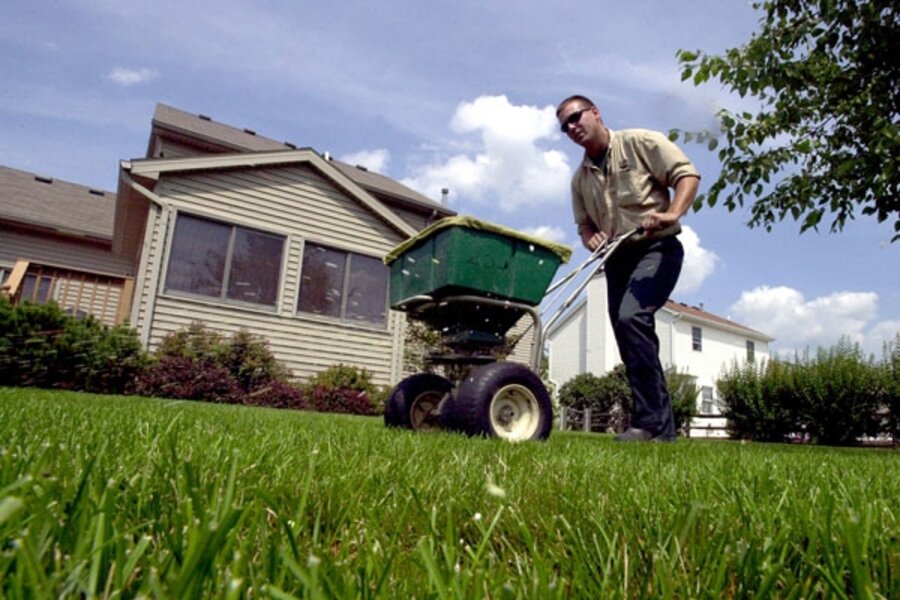Choosing the right fertilizer for your lawn or garden
Loading...
You won't need a dirt doctor to tell you when the soil in your yard is ailing; the vital signs will be obvious. Grass becomes thin and crowded with weeds. Garden vegetables die back. Flowers fade before blooming. Fruit is slow to ripen.
Probably your planting beds are starved for nutrients — some fertilizer. But what kind and how much? That's when the horticultural equivalent of a physical exam comes into play: a soil test.
"Whether you choose to buy manure or commercial fertilizer is up to you, but a soil test will determine which nutrients are needed," says Steve Heckendorn, manager of the soil-testing lab at Virginia Tech in Blacksburg. "You're not fertilizing the plant. You're fertilizing the soil that feeds the plant. In effect, you're putting food into the plant's refrigerator."
There are hundreds of different soil types in America, each with its own characteristics. A soil test rates them for many things, ranging from texture and water retention ability to their yield potential for specific crops. Nutrient deficiencies are identified along with recommendations for changes.
Used to be, shopping for fertilizer blends was a challenge in chemical code breaking, but the standardized three-digit grade labels now required on bags show at a glance what you need to know.
The first number represents the amount of nitrogen available in the mixture, the second the available phosphate, and the last is potash. If the bag label reads "10-10-10," that means a mixture of 10 percent nitrogen, 10 percent phosphate, and 10 percent potash.
"Nitrogen is associated with color, phosphorous with flowering, and potassium with growth," says Dennis Lukaszewski, urban gardens director for the University of Wisconsin-Extension. "There are other micro-nutrient blends out there for feeding specific plants, but those are the big three."
Here are some fertilizing do's and don'ts:
– Manure has been the fertilizer of choice since the first gardeners turned their first clumps of earth. But be cautious if you have access to the nitrogen-rich farmyard variety.
"Make sure it's fully composted," says Mike Goatley, the extension turfgrass specialist at Virginia Tech. "Fresh manures can burn up plants. Odors can be a problem. It may be something you want to avoid if it's at a stage where it's unattractive to the touch or smell."
– Beware synthetic fertilizers blended with herbicides or insecticides. "The fertilizers we use for lawns are not intended for the vegetable garden," Mr. Goatley says. "They may contain ingredients that don't belong in the food chain."
– If some fertilizer is good, more is not necessarily better. "You can overload the system," Goatley says. "You'll get too much green and too much growth, but too little flowering. All that nitrogen will produce is vegetation when what you really want is fruit."
– Slow-release fertilizers can be effective over long periods of time, but they're not a quick fix. You may want to apply a faster-acting product if your ground is nutrient-deficient.
– Know when to apply. "Fertilizing a lawn in the fall will benefit you in the spring," Goatley says. Also, "fertilize gardens when something is actively growing. That's when you get the most benefit."
– Organic products generally are a slower, more natural way to fertilize. "You won't run the risk of a plant taking off" with leggy growth, Wisconsin's Mr. Lukaszewski says. "You'll get a good nutrient balance."
– Don't forget the soil pH or its degree of acidity and alkalinity. An acidic soil has a pH value of less than 7 on a scale of 1 to 14. Acidity influences the vulnerability of plants to disease and the availability of soil nutrients. If soils are acidic, amend them by adding agricultural lime or fireplace ashes. Applying sulfur can neutralize alkaline soils, or those testing above 7.
"My bottom line is, learn what you're doing before you waste money and harm the environment," Lukaszewski says. "The commercial stuff that's out there has been pretty much tested and will be of benefit. But you've got to know what you need and what the product will do."
For more information, see this North Carolina Agronomic Division fact sheet about fertilizer labels.
And if you need to learn how to test your test, click here for instructions.
Editor’s note: For more on gardening, see the Monitor’s main gardening page, which offers articles on many gardening topics. Also, check out our blog archive and our RSS feed. You may want to visit Gardening With the Monitor on Flickr. Take part in the discussions and get answers to your gardening questions. If you join the group (it’s free), you can upload your garden photos and enter our contests.





